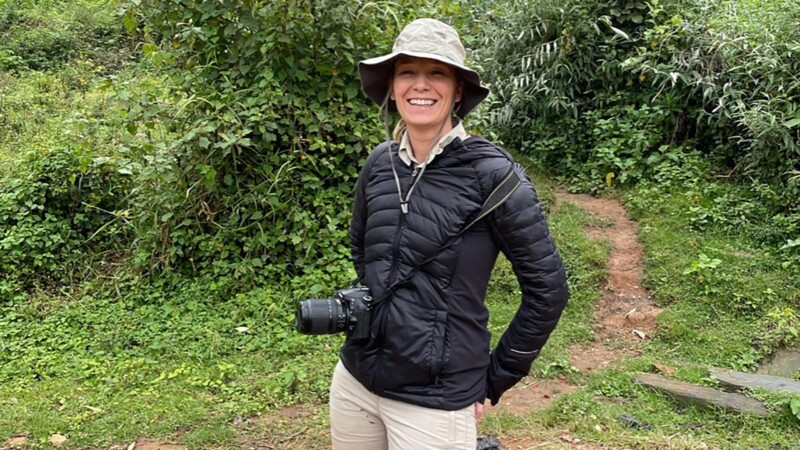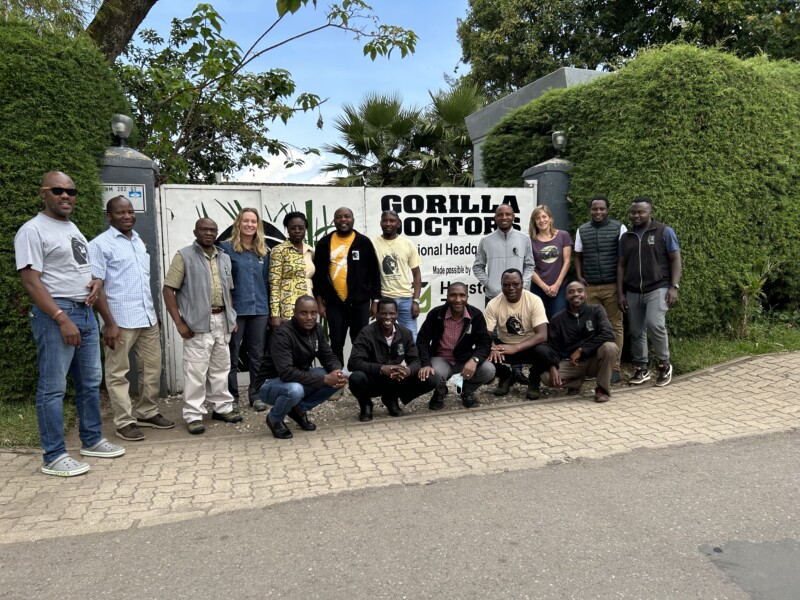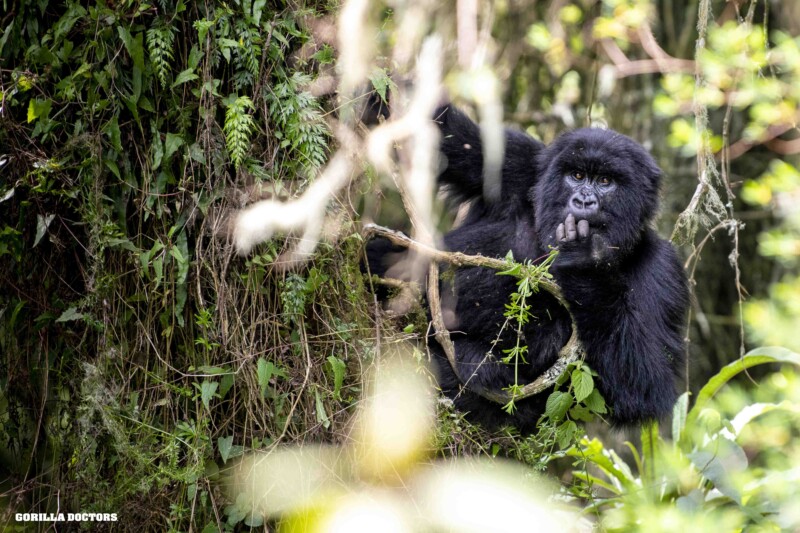Five Questions for Gorilla Doctors New CVSO
By Gorilla Doctors Staff on Monday, March 27th, 2023 in Blog.Meet Dr. Tierra Smiley Evans
In our most recent newsletter we introduced you to Dr. Tierra Smiley Evans, Gorilla Doctors’ new Chief Veterinary and Scientific Officer (CVSO). We sat down with Dr. Tierra to ask her a few more questions now that she is a full two and a half months on the job…

Dr. Tierra Smiley Evans about to trek into Bwindi Impenetrable National Park, Uganda. © Gorilla Doctors
1) Dr. Tierra, you’ve been on the job now for just over two months, what was your first priority stepping in as the organization’s first Chief Veterinary & Scientific Officer?
One of my first priorities was to co-design our 5-year medicine and science strategic plan. Within a month of starting, I was in Rwanda with all our staff from Rwanda, Uganda and DR Congo. We had a fun and inspirational team building event. It was a great way to kickstart my new position and learn from each member of the team what are their individual clinical and scientific interests. I also brainstormed with each team member about where they personally would most like to contribute to our understanding of eastern gorilla health and the advancement of great ape medicine. My role is really to help create the scientific roadmap and to provide support and encouragement for our team along the way. They’ve been doing this a lot longer than me!

Drs. Tierra and Kirsten with team at Gorilla Doctors Regional HQ for science strategy brainstorming. © Gorilla Doctors
2) The Washington Post feature does a nice job highlighting the role of scientific research on infectious diseases in our mission to protect the health of wild eastern gorillas. Can you give us a brief overview of your vision for our future research on infectious diseases and how it will help us keep the gorillas healthy?
Gorilla Doctors is the only organization in the world practicing great ape clinical veterinary medicine in the forest at the level of the population – so, we care both for individual gorillas but also compile health data over time to analyze population health trends. It’s really astounding what Gorilla Doctors accomplished in the past three decades as they have pioneered great ape field medicine while advancing a One Health approach to protecting gorilla health. I am joining this organization at a very exciting time – when fields of medicine and therapeutics are accelerating at an exponential rate. At the same time, society is starting to truly understand and appreciate the importance of human impacts on the environment and wildlife populations, including the implications this can have for human and animal health.
My vision for Gorilla Doctors is that we will harness the medical and technological breakthroughs in human medicine to advance and achieve best possible medicine for eastern gorillas in the wild. Our hospital may be the forest, but we can greatly benefit great ape clinical knowledge by creatively adapting new technologies and treatments for use in the field.
We also know that infectious diseases will continue to threaten the survival of gorillas. I would like to see Gorilla Doctors build on their leadership in surveillance and investigational research on infectious pathogens impacting or threatening eastern gorilla health. And for this, we must continue to model a One Health approach – understanding that the infectious disease threats to gorillas cannot just involve gorillas – we must also understand what is circulating in nearby human and other wildlife populations as well to address the health of all.

Mountain gorilla in Volcanoes National Park, Rwanda feeding on vines. © Skyler Bishop for Gorilla Doctors
3) You are an epidemiologist by training, what exactly is the study of epidemiology and how does it serve wildlife conservation?
Epidemiology involves a different approach to medicine, where the ‘patient’ is the whole community or population, not a single individual. This field of study is very important for wildlife conservation because it directly assesses the distribution and determinants of health in specific populations. When you’re managing the health of an endangered species, and in the case of mountain gorillas where there are just over 1,000 remaining, having an understanding of population-level health threats can help prevent or mitigate a threat that could impact the entire population. Epidemiological studies are an important tool for: 1) determining causes of diseases, 2) describing scenarios that impact wildlife population health, and 3) influencing wildlife management policy.
4) How did you first come up with the idea to use saliva as a non-invasive way to collect data in the mountain gorillas?
I first visited the gorillas as a veterinary student in 2007. I had a very basic idea in my mind that I wanted to be able to understand some piece of health information about every single individual gorilla. I think I always leaned towards the field of epidemiology, as I always wanted to understand something about everyone in the group. The idea came about quite naturally as I spent time observing the gorillas on a daily basis. Gorillas are very messy eaters – they leave trails of leftovers everywhere they go. So, it seemed like a logical thing to investigate the easiest sample type to collect. At that time, they were also making lots of new advancements in human medicine around saliva diagnostics, so I knew if we could just collect the right specimen, it would theoretically be valuable.

Dr. Tierra and Dr. Fred collect data in Bwindi Impenetrable National Park, Uganda, 2013. © Gorilla Doctors
5) What first sparked your interest in wildlife and veterinary medicine?
I grew up on a small farm in Northern California where animals were a daily part of our lives. Some of my earliest memories involve playing “veterinarian” on our horses, sheep or geese. I knew I wanted to be a veterinarian from very early on and I really liked the idea of learning skills that would allow me to “fix” things. I thought one day I would become a mixed animal clinician in my hometown, something along the lines of James Herriot, my childhood idol. At that time, I certainly never imagined my future career would take me all over the world and allow me to work on diseases shared between humans and animals.
Later, while working on my undergraduate degree, I had the opportunity to join the caregiving team of a gorilla sign-language project, a rather unique first job. My initial role was to make meals for the gorillas, something that seemed simple enough, but quickly evolved to working closely with daily caregiving and enrichment activities for two captive Western lowland gorillas. Learning how similar they are to us both from a health but also a psychological standpoint captured my fascination and solidified my determination to become a veterinarian and to focus on great apes in the wild in their natural setting.


 Donate
Donate